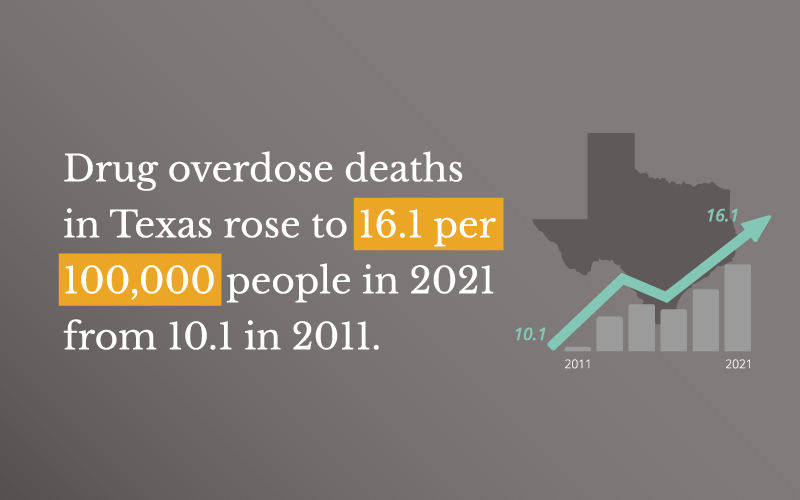Substance Use Disorders:
A Comprehensive Overview
Written and reviewed by our Clinical Director, Larissa Valeriano, MS, LPC
What is a Substance Use Disorder?
A substance use disorder (SUD) is a condition where a person has difficulty controlling their use of drugs or alcohol. It’s a serious health issue that can affect people of all ages and backgrounds. In 2022, more than 48 million people aged 12 or older struggled with a substance use disorder.1
- Suffering relationships
- Neglecting responsibilities at work or school
- Legal issues

How are Substance Use Disorders Classified?
Substance use disorders are classified based on criteria outlined in the Diagnostic and Statistical Manual of Mental Disorders (DSM-5). The classification helps in understanding the severity and specific characteristics of different disorders.2
- Pharmacological criteria such as tolerance and withdrawal symptoms
- The presence of impaired control over substance use
- Social impairment
- Risky use
Substance Categories
- Alcohol
- Opioids
- Stimulants
- Sedatives
- Tobacco
- Hallucinogens
- Cannabis
Severity Levels
Comorbidity
- Mood disorders
- Anxiety disorders
- Personality disorders
Withdrawal Symptoms
Many substances can lead to withdrawal symptoms when their use is abruptly reduced. Withdrawal symptoms can range from mild discomfort to severe physical and psychological distress.

Risk Factors for Developing Substance Use Disorders
Genetics and Family History
Environmental Factors
- Peer pressure
- Exposure to substance use
- Negative life events
Childhood Adversity
- Neglect
- Abuse
- Household dysfunction
How Adverse Childhood Experiences (ACEs) Can Lead to SUD and Mental Health Challenges
Personal Factors
- A lack of self-control
- Impulsivity
- Sensation-seeking behavior
- A tendency to take risks
Socioeconomic Factors
- Low income
- Unemployment
- Limited educational opportunities
Early Substance Use
Symptoms of Substance Use Disorders
Changes in Appearance
- Bloodshot eyes
- Dilated or constricted pupils
- Poor hygiene
- Skin problems
Changes in Appetite
Poor Coordination and Motor Control
Mood Swings
- Irritability
- Anger
- Sadness
- Euphoria
Anxiety and Depression
Substance misuse often leads to the development of anxiety and depression symptoms. These may include:
- Persistent worry
- Restlessness
- Feelings of hopelessness
- Loss of interest in activities once enjoyed
Emotional Instability
Increased Risk of Suicidal Thoughts
Neglecting Responsibilities
Loss of Interest in Hobbies
Financial Problems
Social Isolation
What Substances Most Commonly Lead to SUD?
Opioids
- Oxycodone
- Vicodin
- Fentanyl
Alcohol
Benzodiazepines
- Xanax
- Valium
- Ativan
Methamphetamine
Marijuana (Cannabis)
Nicotine
Nicotine Addiction and Withdrawal
Cocaine
Hallucinogens

How Common is SUD in the U.S.?
Alcohol Use Disorder (AUD)
Drug Use Disorder (DUD)
Co-Occurrence of AUD and DUD
Mental Illness
Serious Thoughts of Suicide
How Common is SUD in Texas?

Why are Substance Use Disorders so Common?
Cultural Influences
Lack of Education and Awareness
Availability and Accessibility
Use of Prescription Drugs
Marketing and Advertising
Treatment Programs for Substance Use Disorders
Continuum Outpatient Center offers several treatment programs for SUD recovery. Our aim is to help people overcome addiction and achieve long-term recovery.
"At Continuum Outpatient Center, determining the appropriate level of care for a patient with a substance use disorder involves a detailed, individualized assessment process. This starts with a comprehensive medical and psychiatric evaluation, alongside a thorough history of substance use and a psychosocial assessment. We utilize evidence-based tools like the ASAM Criteria, which assess dimensions such as withdrawal potential, biomedical conditions, and recovery environment. Based on these assessments, we recommend one of several levels of care, which may include outpatient services, an intensive outpatient program, or a partial hospitalization program. Each patient’s treatment plan is personalized and includes continuous monitoring and adjustments to ensure effective, responsive care. This approach ensures each patient receives the most suitable and effective treatment, promoting successful recovery and long-term sobriety."
Larissa Valeriano, MS, LPC Tweet
Partial Hospitalization Program (PHP)
Intensive Outpatient Program (IOP)
Drug Rehab Aftercare
Therapeutic Interventions Used to Treat Substance Use Disorders
Cognitive Behavioral Therapy (CBT)
"At Continuum Outpatient Center, we use a variety of evidence-based practices to treat substance use disorders effectively. Cognitive-behavioral therapy (CBT) is central to our approach, helping patients identify and change harmful thought patterns and behaviors. We also employ medication-assisted treatment (MAT) for opioid and alcohol use disorders, combining medications with counseling to reduce cravings and withdrawal symptoms. Motivational interviewing (MI) is used to enhance patients' motivation and commitment to change. Additionally, we encourage participation in 12-step programs for peer support and structure. Our treatment also addresses co-occurring mental health disorders to ensure comprehensive care. These practices collectively provide a solid foundation for long-term recovery."
Larissa Valeriano, MS, LPC Tweet
Dialectical Behavioral Therapy (DBT)
- Emotional regulation
- Effective communication
- Distress tolerance
- Mindfulness
What is DBT?: A Closer Look
Experiential Therapy
Medication Assisted Treatment (MAT)
"At Continuum Outpatient Center, medication-assisted treatment (MAT) plays a crucial role in our approach to managing substance use disorders. The medications we use, such as buprenorphine, methadone, and naltrexone, help reduce cravings and withdrawal symptoms, making it easier for patients to focus on their recovery journey. Our integrated approach ensures that MAT is tailored to each patient's specific needs, taking into account their medical history, substance use patterns, and co-occurring mental health conditions. By alleviating the physical discomfort associated with withdrawal and reducing the risk of relapse, MAT enables patients to engage more fully in therapy and other support services. This holistic strategy not only addresses the biological aspects of addiction but also supports the psychological and social dimensions of recovery."
Larissa Valeriano, MS, LPC Tweet
Dual Diagnosis Treatment
Meditation
Post-Traumatic Stress Disorder (PTSD) Therapy
What to Expect From SUD Treatment
Assessment and Evaluation
Individualized Treatment Plan
- Detoxification
- MAT
- Counseling
- Other assistance
Detoxification
Therapy and Counseling
- Individual counseling
- Group therapy
- Family therapy
Education and Skill Building
- Addiction
- How to prevent relapse
- Developing important life skills
Supportive Services
Continued Care and Aftercare
- Outpatient therapy
- Programs to help prevent relapse
- Weekly alumni meetings
"At Continuum Outpatient Center, we adopt a multi-faceted approach that combines evidence-based therapies, continuous monitoring, and robust support systems to address the risk of relapse. We also emphasize the importance of aftercare planning, ensuring that patients have access to ongoing support through outpatient services, support groups, and 12-step programs. Regular follow-up appointments allow us to monitor progress and intervene early if signs of relapse appear. Additionally, we educate patients about relapse triggers and equip them with practical skills to manage cravings and stress. Family involvement and education also play a crucial role, as a supportive home environment significantly reduces the risk of relapse. By addressing both the psychological and social aspects of addiction, we create a comprehensive support network that fosters long-term recovery and resilience against relapse."
Larissa Valeriano, MS, LPC Tweet

How Can Continuum Outpatient Center Help?
Tailored Treatment Plans
We create personalized treatment plans based on each person’s unique needs — one that can be pivoted as treatment progresses. Our team of experts assesses the challenges and goals of each person in detail. By tailoring the treatment plan for every client, we can provide targeted care to increase the chances of successful recovery.
"We measure the outcomes and effectiveness of our substance use disorder treatments through a combination of patient progress tracking, standardized assessment tools, and follow-up evaluations. We monitor each patient's progress using regular check-ins and assessments to evaluate changes in substance use patterns, mental health status, and overall well-being. Additionally, we gather feedback through patient self-reports and satisfaction surveys, which offer insights into their experiences and perceptions of the treatment. Long-term follow-up evaluations help us assess the sustainability of recovery and identify any ongoing support needs. By analyzing this feedback, we can make informed adjustments to treatment plans, ensuring they remain effective and responsive to each patient's evolving needs. This comprehensive approach allows us to continuously improve our treatment programs and maximize the chances of successful, long-term recovery for our patients."
Larissa Valeriano, MS, LPC Tweet
Relapse Prevention Strategies
Preventing relapse is crucial in the recovery journey. At Continuum Outpatient Center, we equip people with skills to maintain sobriety. Through educational sessions, coping mechanisms, and relapse prevention planning, they learn how to handle triggers and challenges in their daily lives.
Holistic Approach
Family Involvement and Support
Begin Your Recovery from Substance Use Disorders With Continuum Outpatient Center
Resources
- https://www.samhsa.gov/newsroom/press-announcements/20231113/hhs-samhsa-release-2022-nsduh-data
- https://www.ncbi.nlm.nih.gov/pmc/articles/PMC5039518/
- https://www.ncbi.nlm.nih.gov/pmc/articles/PMC5911369/
- https://www.sciencedirect.com/science/article/abs/pii/S0376871621000582
- https://store.samhsa.gov/sites/default/files/d7/priv/sma16-4935.pdf
- https://www.cdc.gov/opioids/data/index.html#:~:text=The%20Drug%20Overdose%20Epidemic%3A%20Behind,1999%20from%20a%20drug%20overdose.&text=More%20than%2075%25%20of%20drug,in%202021%20involved%20an%20opioid.&text=Opioids%20are%20substances%20that%20work,reduce%20the%20intensity%20of%20pain
- https://nida.nih.gov/research-topics/trends-statistics/overdose-death-rates
- https://www.cdc.gov/marijuana/data-statistics.htm
- https://www.statista.com/statistics/806271/past-year-cocaine-use-us-adults/
- https://www.samhsa.gov/newsroom/press-announcements/20231113/hhs-samhsa-release-2022-nsduh-data
- https://www.kff.org/statedata/mental-health-and-substance-use-state-fact-sheets/texas/


